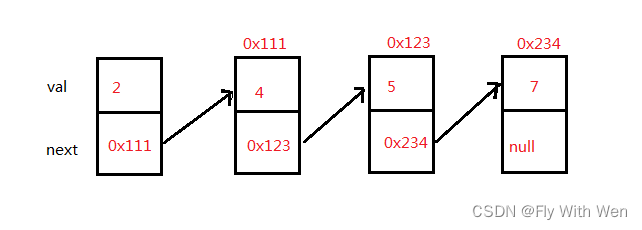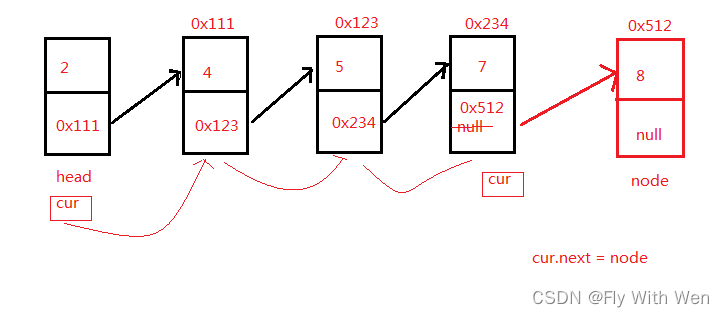目录
1.概念及结构
链表是一种物理存储结构非连续存储结构,数据元素的逻辑顺序是通过链表中的引用链接次序实现的 。
无头单相飞循环链表的一个节点含有value(存放数值的) 、 next(下一个节点的地址)

2.创建一个单链表的类
创建的这个类用于下面的方法引用
class ListNode {
public int val;
public ListNode next;//节点的地址
public ListNode(int val) {
this.val = val;
}
}3.头插法
头插法就是在原来的链表前面增加一个新节点,然后再使新节点变为头节点

public void addFirst(int data) {
ListNode listNode = new ListNode(data);//插一个新的节点
listNode.next = this.head;//绑定位置先绑定后面的位置
this.head = listNode;
}4.尾插法
先定义一个 cur 引用头结点,然后遍历一遍链表,直到找到尾节点就停止,尾节点就是next域为null。
如果链表为空的,则尾插的第一个就作为链表的头结点

public void addLast(int data) {
ListNode listNode = new ListNode(data);
if(this.head == null) {
this.head = listNode;
}else {
ListNode cur = this.head;
while (cur.next != null) {
cur = cur.next;
}
cur.next = listNode;
}
}5.任意位置插入
在任意位置插入节点时,我们先找到要插入节点位置前的一个节点,任意位置包括了头插、尾插和中间位置。

//找到index-1 位置节点的地址
public ListNode findIndex(int index) {
ListNode cur = this.head;
while (index-1 != 0) {
cur = cur.next;
index--;
}
return cur;
}
//任意位置插入,第一个数据节点为0号下标
public void addIndex(int index,int data) {
if(index < 0 || index >size()) {
System.out.println("位置不合法");
return;
}
if(index == 0) {
addFirst(data);
return;
}
if(index == size()) {
addLast(data);
return;
}
ListNode cur = findIndex(index);
ListNode node = new ListNode(data);
node.next = cur.next;
cur.next = node;
}6.删除节点
删除节点要先找到要删除前的节点

//找到要删除关键字的前一个节点
public ListNode searchPerv(int key) {
ListNode cur = this.head;
while (cur.next != null) {
if(cur.next.val == key) {
return cur;
}
cur = cur.next;
}
return null;
}
//删除第一次出现关键字为key的节点
public void remove(int key) {
if(this.head == null) {
System.out.println("单链表为空,不用删除");
return;
}
if(this.head.val == key) {
this.head = this.head.next;
return;
}
ListNode cur = searchPerv(key);
if(cur == null) {
System.out.println("没有你要删除的节点");
return;
}
ListNode del = cur.next;//将删除的节点与上一个节点连接
cur.next = del.next;//将删除的节点的 左右两边的 节点 连接,从而删除的节点没有连接就被去掉了
}
//删除所有值为key的节点
public ListNode removeAllKey(int key) {
if(this.head == null) return null;
ListNode prev = this.head;
ListNode cur = this.head.next;
while (cur != null) {
if(cur.val == key) {
prev.next = cur.next;
cur = cur.next;
}else {
prev = cur;
cur = cur.next;
}
}
//最后处理头节点
if(this.head.val == key) {
this.head = this.head.next;
}
return this.head;
}7.链表长度
public int size() {
int count = 0;
ListNode cur = this.head;
while(cur != null) {
count++;
cur = cur.next;
}
return count;
}8.打印链表
public void display() {
ListNode cur = this.head;
while (cur != null) {
System.out.print(cur.val+" ");
cur = cur.next;
}
System.out.println();
}9.清空链表
public void clear() {
while (this.head != null) {
ListNode curNext = head.next;
this.head.next = null;
this.head =curNext;
}
}